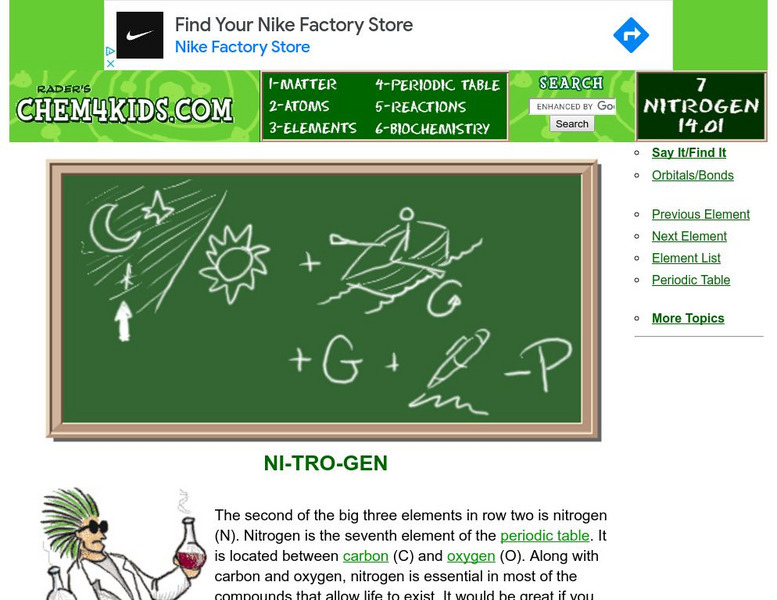Environmental Chemistry
Environmental chemistry.com: Periodic Table Potassium
As the name of this site implies, this is a huge reference site for elemental information. Whether you are looking for properties or isotopes, this site probably has what you need. Images of structure and electron energy level can be...
Other
Especial Gas Inc.: Sulfur Properties and Compounds
This page from Especial Gas Inc. contains some very interesting information about the element sulfur, and some of its common compounds. The history and relative abudance of the element is discussed, as well as where it can be found. The...
Thomas Jefferson National Accelerator Facility
Jefferson Lab: It's Elemental the Element Actinium
Facts and historical information on the element of Actinium.
Royal Society of Chemistry
Chemical Society: Argon
This site, which is provided for by the Chemical Society, gives a small amount of basic information on argon, including its history and uses.
Royal Society of Chemistry
Royal Society of Chemistry: Nitrogen
A short but nice description of nitrogen's uses and properties. Discusses the history of nitrogen and its characteristics.
Science Education Resource Center at Carleton College
Serc: Group and Periodic Properties Lab
Students observe and perform experiments with sodium, potassium, calcium, magnesium, sulfur ,and phosphorus. The discover trends down groups, across periods, and having to do with the pH of metal oxides vs. nonmetal oxides.
Science Education Resource Center at Carleton College
Serc: Elements Metals, Nonmetals and Metalloids
Students investigate several properties of the given elements and decide whether each element is a metal, non-metal, or a metalloid.
CK-12 Foundation
Ck 12: Life Science: 2.1 Elements and Compounds
Learn how basic elements form molecules to support life.
Chem4kids
Chem4 Kids: Beryllium
Here at Chem4Kids you can find some great information about the 4th element in the periodic table, "beryllium." Content focuses on beryllium's electrons, where you can find beryllium in nature, and how beryllium combines with other...
Chem4kids
Chem4 Kids: Nitrogen (N)
Here you can find some great information about the 7th element in the periodic table, "nitrogen." Content focuses on nitrogen's electrons, where you can find nitrogen in nature and in the home, and how nitrogen combines with other elements.
Chem4kids
Chem4 Kids: Fluorine
Here you can find some great information about the 9th element in the periodic table, "fluorine." Content focuses on fluorine's electrons, where you can find fluorine in nature and in the home, and how fluorine combines with other elements.
Chem4kids
Chem4 Kids: Neon (Ne)
Here you can find some great information about the 10th element in the periodic table, "neon." Content focuses on neon's electrons, where you can find neon in nature and in the home, and how neon combines with other elements.
Chem4kids
Chem4 Kids: Sodium (Na)
Here at Chem4Kids you can find some great information about the 11th element in the periodic table, "sodium." Content focuses on sodium's electrons, where you can find sodium in nature and in the home, and how sodium combines with other...
Chem4kids
Chem4 Kids: Sulfur (S)
Here you can find some great information about the 16th element in the periodic table, "sulfur." Content focuses on sulfur's electrons, where you can find sulfur in nature and in the home, and how sulfur combines with other elements.
Chem4kids
Chem4 Kids: Boron
Here at Chem4Kids.com you can find some great information about the 5th element in the periodic table, "boron." Content focuses on boron's electrons, where you can find boron in nature and in the home, and how boron combines with other...
Chem4kids
Chem4 Kids: Carbon
Click on the left navigation terms for some great information about the 6th element in the periodic table, "carbon." Content focuses on carbon's electrons, where you can find carbon in nature and in the home, and how carbon combines with...
Chem4kids
Chem4 Kids: Magnesium (Mg)
Here you can find some great information about the 12th element in the periodic table, "magnesium." Content focuses on magnesium's electrons, where you can find magnesium in nature and in the home, and how magnesium combines with other...
Chem4kids
Chem4 Kids: Silicon (Si)
Here you can find some great information about the 14th element in the periodic table, "silicon." Content focuses on silicon's electrons, where you can find silicon in nature and in the home, and how silicon combines with other elements.
Chem4kids
Chem4 Kids: Phosphorus (P)
Here you can find some great information about the 15th element in the periodic table, "phosphorus." Content focuses on phosphorus' electrons, where you can find phosphorus in nature and in the home, and how phosphorus combines with...
Chem4kids
Chem4 Kids: Argon (Ar)
Chem4Kids looks at the 18th element in the periodic table, argon. Content focuses on argon's electrons, where you can find argon in nature and in the home, and how argon combines with other elements.
Chem4kids
Chem4 Kids: Chlorine (Cl)
The 17th element in the periodic table is defined, chlorine. Find out how many electrons chlorine has and where you can find it in nature and in the home.
School of Biological and Chemical Sciences, Queen Mary University of London
Queen Mary Univ.: Atomic Weights of the Elements 2017
This site from the Queen Mary University of London provides a list of the discovered atomic weights and elements up into the year 2017.
Ducksters
Ducksters: Chemistry for Kids: Elements: The Noble Gases
Study the noble gases on this site. Learn about where to find them on the periodic table, what elements are in this group, and other facts.
Ducksters
Ducksters: Chemistry for Kids: Elements: Nonmetals
Kids learn about the nonmetals of the periodic table. Which elements are in this group. Properties, similarities, and other facts are found on this site.





















